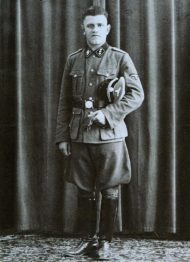SS Personnel
Administrative routine shaped daily life in the Kommandant headquarters of the camp SS. The SS administrative staff was deeply involved in the crimes committed at the camp. They deliberately provided too little nourishment and inadequate medication to the prisoners. The SS bureaucratic routine encompassed the most brutal punishment, the murder of prisoners, and the disposal of the dead.
Guard duty constituted an aspect of daily work for most SS men. The majority of guards regarded the prisoners as a faceless, anonymous mass. Criminal actions were everyday occurrences.
Kommandant
-
Jakob Weiseborn (1892–1939)
Jakob Weiseborn was born in Frankfurt am Main. He left middle school without completing an apprenticeship or training in a profession, and served in the First World War.
-
![]()
Picture: Federal Archives Berlin He married in 1924, and had one son. In 1931, Weiseborn joined the Nazi Party and the SS. After 1935, he was a guard at the Dachau, Columbia-Haus and Esterwegen concentration camps, and subsequently held leading positions in Dachau, Sachsenhausen and Buchenwald.
In May 1938, Weiseborn was appointed first Kommandant of the Flossenbürg camp. The camp was built during his tenure, but little is known about his activities there. Weiseborn died under unknown circumstances on January 20, 1939.

-
Karl Künstler (1901–1945)
Karl Künstler was born in Zella, in the Mühlhausen district of Thuringia. After leaving school, he worked first for the postal service, and then joined the German army.
-
![]()
Picture: Federal Archives Berlin In 1932, he joined the Nazi Party and the SS. After 1935, Künstler was an instructor in the SS Officers’ School in Tölz, and later was a chief guard in the Columbia-Haus and Dachau concentration camp guard units.
In January 1939, Künstler was appointed Kommandant at the Flossenbürg concentration camp. He authorized executions and condoned cruelty, and granted special leave to guards who shot prisoners attempting to escape. Künstler was well known for his abuse of alcohol. After a drinking bout, he was transferred by the SS leadership to the Balkans in September 1942. Künstler died shortly before the end of the war in battle near Nuremberg.
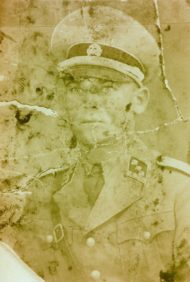
-
Egon Zill (1906–1974)
Born in Plauen, Egon Zill apprenticed in the baking trades after completing the eighth grade at the public elementary school.
-
![]()
Picture: Federal Archives Berlin He joined the Nazi Party and the SA at age 17. In 1926, Zill joined Saxony’s first SS unit. He worked as an assistant in several companies, and then became a porter in a factory. Beginning in 1934, Zill was employed at the Hohenstein, Lichtenburg, Dachau and Ravensbrück camps.
After serving as Kommandant at the Natzweiler camp, Zill was appointed Kommandant of the Flossenbürg concentration camp in September 1942. One year later, he was transferred to the front for unknown reasons.
Zill was arrested in 1952 and sentenced to life imprisonment, but was released in 1963. After his release, Zill lived in the town of Dachau until his death.

-
Max Koegel (1895–1946)
Born in Füssen, Max Koegel was orphaned and raised by relatives. He first worked as a dairy assistant and mountain guide.
-
![]()
Picture: Federal Archives Berlin After returning from the First World War, he pursued various occupations. Koegel joined the Nazi Party, SA, and SS in 1932, founding the first SS unit in Füssen. In April 1933, he was hired by the Dachau concentration camp. There he entered his second marriage; he had no children. He later worked at the Columbia-Haus, Sachsenhausen, Lichtenburg, Ravensbrück and Majdanek camps.
In May 1943, Koegel was appointed Kommandant of the Flossenbürg camp. Locally, he had a reputation for great friendliness. In the camp, he allowed prisoners to be abused and killed. Koegel went underground at the end of the war.
In 1946, he committed suicide following his arrest.
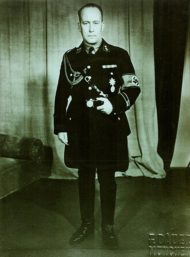
Adjutancy
-
August Harbaum (1913–unknown)
August Harbaum was born in Gütersloh. At fourteen, he joined the radical rightist Youth Steel Helmet organization.
-
![]()
Picture: Federal Archives Berlin He found only temporary employment after completing a business apprenticeship. In 1932, he joined the Nazi Party and SS, leaving his civilian employment to take a full-time SS position. In fall 1934, Harbaum registered at the SS school at Wewelsburg. After a disciplinary infraction, he was transferred to the Sachsenhausen camp for training, and then assigned to the Dachau camp guard unit.
In March 1939, Harbaum was appointed adjutant at the Flossenbürg concentration camp. There are no records of his interactions with prisoners. In February 1940, he was transferred to Oranienburg, where he headed the main personnel department in the office of the Inspector of Concentration Camps.
Nothing is known about his subsequent career.
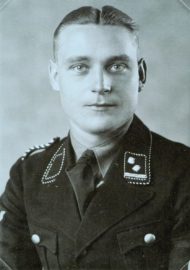
-
Ludwig Baumgartner (1909–unknown)
Ludwig Baumgartner was born in Nersingen in Bavaria. After leaving school, he worked in banking, and was employed by the Gewerbebank Ulm until 1931.
-
![]()
Picture: Federal Archives Berlin Later he worked as a clerk in a perfume wholesale company. He joined the Nazi Party, SA, and SS at twenty-two. Beginning in summer 1934, he worked at the Oranienburg and Sachsenhausen camps.
In spring 1940, Baumgartner was appointed adjutant at the Flossenbürg concentration camp. He was centrally involved in crimes committed at the camp. Due to a knee injury, he was never transferred to the front, remaining at Flossenbürg until the war’s end.
At the end of the war, Baumgartner went underground, and has since been listed as missing.
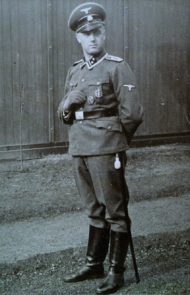
-
Johanna Rautschka (1924–unknown)
Johanna Rautschka was born in Ulibitz in the Sudetenland. She attended a public vocational school in Bischofteinitz.
-
![]()
Picture: Federal Archives Berlin Rautschka was influenced by the growing National Socialist movement in the Sudetenland at a young age, becoming a member of the German Gymnastics Association and the Youth Movement of the Sudeten German Party. After attending business school in Regensburg, she was assigned by the District Administrator of Bischofteinitz to service with the SS. In 1944, she received training as a signaler at the SS Reich School in Oberehnheim, Alsace. She then worked as a signaler in the Auschwitz concentration camp.
Rautschka was transferred to the Information Office at the Flossenbürg concentration camp in 1945. Nothing is known about her subsequent career.
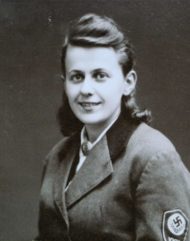
Political Division (Gestapo)
-
Wilhelm Faßbender (1892–1970)
Born in Cologne, Wilhelm Faßbender attended elementary school and then trained as a druggist. From 1912 to 1918, he served in the army.
-
He married in 1914, and had two daughters. In 1922, Faßbender began his service in the police force. He joined the Nazi Party in 1933, and briefly was a member of the SA.
In October 1938, Faßbender was transferred to the Flossenbürg concentration camp as a detective of police, where he headed the Political Division (Gestapo). The members of the Political Division used torture to obtain confessions from prisoners. Faßbender did not become an SS member until 1940. In 1943, he was transferred to the Cologne Kripo (criminal investigation department).
After the war, Faßbender worked in Cologne as a private detective. Two judicial inquiries were opened against him, but both cases were dropped.
-
Fritz Schlundermann (1908–1989)
Fritz Schlundermann was born in Hagen-Haspe. After completing secondary school, he began an apprenticeship at the Deutsche Bank und Diskontogesellschaft.
-
![]()
Picture: Federal Archives Berlin Following a brief period of unemployment in 1931, he took an office position in Dortmund with the Barmer Ersatzkasse health insurance company. He joined the Nazi Party and the SS in 1933.
In February 1941, Schlundermann was transferred to the Flossenbürg concentration camp, assigned initially to the guard division. He was reassigned to the Political Division (Gestapo) in late 1942. From 1943 to the war’s end, he headed the Registry Office of the Kommandant Headquarters. According to prisoners, Schlundermann was known for his brutality.
After the war, Schlundermann lived undisturbed first in Paderborn, and later in Iserlohn.
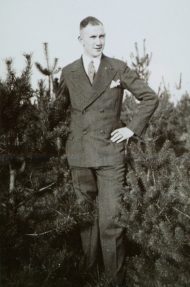
-
Wilhelm Stieger (1910–unknown)
Wilhelm Stieger was born in Essen-Werden. He studied business and law, obtaining a doctorate in both fields.
-
After completing his degrees, he worked as an auditor. He joined the SS and the Nazi Party in 1933. In September 1939, he was drafted into an SS infantry regiment, from which he was discharged one year later.
In 1941, Stieger was drafted once again, this time into service at the Flossenbürg concentration camp, where he worked in the guard units and the Political Division (Gestapo). He was transferred to the SS administration in Berlin in November 1941. Among his duties, Stieger worked on matters concerning SS members’ family allowances at the Race and Settlement Main Office.
Nothing is known about his later career.
Detention Camp Headquarters
-
Johann Aumeier (1906–1948)
Johann Aumeier was born in Amberg in the Oberpfalz region. He apprenticed as a mechanic after leaving school.
-
![]()
Picture: Auschwitz-Birkenau State Museum, Oświęcim He worked as a mechanic until 1929, and then was employed by the National Socialist party. He married in 1931, and had one daughter. Beginning in 1934, he worked in the guard units at the Dachau, Esterwegen, Lichtenburg and Buchenwald camps.
In May 1938, Aumeier was transferred to the Flossenbürg concentration camp to head the detention unit, where he participated in mass executions. He was transferred again in early 1942, holding leading positions at the Auschwitz, Vaivara, Dachau and Mysen (Oslo) camps until the end of the war.
Aumeier was tried for his crimes before a Polish court in 1948. He received the death penalty and was executed that same year.
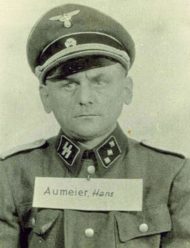
-
Karl Fritzsch (1903–1945)
Karl Fritzsch was born in Nassengrub (Mokřiny) in the Sudetenland. After completing elementary school, he worked as a roofer, and later worked on boats on the Danube River.
-
![]()
Picture: State Archive of North Rhine-Westphalia, Duisburg He married in 1928, and had three children. In 1930, Fritzsch joined the Nazi Party and the SS. In March 1933, he was drafted to the auxiliary police in Regensburg, and was later transferred to the Dachau concentration camp. After spending seven years at Dachau, Fritzsch assumed a leading position in the construction of the Auschwitz concentration camp.
In January 1942, Fritzsch was transferred to Flossenbürg to head the detention camp. He was known by the prisoners for his extreme brutality. In the penal barrack, he killed prisoners on his own authority. In autumn 1944, Fritzsch was transferred to the front. He was killed in the battle of Berlin.

-
Adolf Nies (1905–1994)
WORK DETAILS
Adolf Nies was born in Weilburg an der Lahn. After completing a mechanical engineering degree, he worked only intermittently.
-
![]()
Picture: Federal Archives Berlin He joined the Nazi Party and the SS in 1933. In 1936, he was hired as a fire inspector.
In early 1941, Nies joined the Flossenbürg camp guard unit. In late summer 1942, he was assigned to the penal block, where he carried out executions. According to prisoner reports, Nies displayed no emotion during executions. He was assigned to the Bayreuth subcamp as commando leader in autumn 1944. After an escape attempt, Nies was transferred to the Mittweida subcamp, again as a commando leader.
After the war, Nies first went underground. He was arrested only after his wife notified the local police registry of a change of residence. In 1955, the Weiden District Court sentenced Nies to a term of four years.
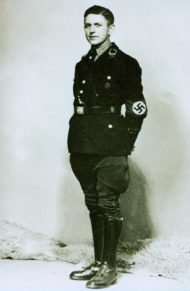
-
Hildegard Krüger (1922–1994)
Born in Berlin, after leaving elementary school Hildegard Krüger worked for the Osram Company in Berlin as a packer.
-
![]()
Picture: Federal Archives Berlin There she was recruited as a guard. In summer 1944, Krüger took part in a course conducted by the troop support unit of the Flossenbürg concentration camp. During the training program, she was subjected to an examination of her criminal history, health, and ideological beliefs. She became a member of the of the support staff of the Armed SS in September 1944, and along with sixteen other course participants was transferred to the Industriewerke A.G. site in Plauen. She began work as a guard in the Zwodau subcamp October 25, 1944. Nothing is known about her interactions with prisoners.
Krüger died in Berlin in 1994.
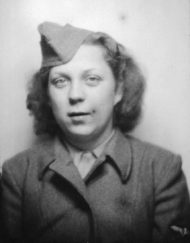
-
Rudi Schirner (1912–1978)
WORK DETAILS
Rudi Schirner was born in Klein-Jena in Saxony-Anhalt. After completing elementary school, he apprenticed as a mechanic but was unable to find employment.
-
![]()
Picture: Federal Archives Berlin In 1931, he joined the SA and the Nazi Party, and one year later also joined the SS. Beginning in September 1933, he worked in the guard units at the Lichtenburg and Buchenwald concentration camps.
In June 1938, Schirner was transferred to Flossenbürg. He encouraged the Kapos in their brutality and abused prisoners, some of whom died as a result. In 1941-42, Schirner participated in mass executions within and outside the detention camp. Beginning in February 1942, Schirner headed the Stulln subcamp. He was transferred to the front in late 1942.
After the war, a former prisoner recognized Schirmer. Schirmer was sentenced to a prison term of eighteen years, but was released in 1953. He lived in Hamburg and in Kaltenkirchen in Schleswig-Holstein until his death.

Administrative Division
-
Hermann Kirsammer (1913–unknown)
Hermann Kirsammer was born in Magolsheim in the Swabian Alb region. After finishing elementary school, he completed a business apprenticeship.
-
![]()
Picture: Federal Archives Berlin He joined the SS in 1934. He was then assigned to work as a guard in the Columbia-Haus and Sachsenhausen camps. From 1939 to 1943, Kirsammer was a senior administrator in an SS combat unit at the front. In October 1943, Kirsammer was transferred to the Flossenbürg concentration camp as head of the camp administration. He worked at Flossenbürg until the end of the war. Nothing is known about his contact with prisoners.
After the war, Kirsammer was arrested. He received a life sentence in 1947, but was released in 1952 for “good conduct.” The details of his later career and life are unknown.
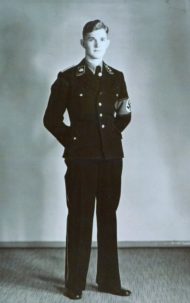
Medical Division
-
Dr. Alfred Schnabel (1888–1955)
Alfred Schnabel was born in Wünschelburg (Radków) in Silesia. After completing a medical degree, he worked at the University Clinic at Jena.
-
![]()
Picture: Federal Archives Berlin He served in the First World War, and then took a position at the University of Breslau clinic. Later he went into private practice as an ear, nose and throat specialist. He joined the Nazi Party and the SS in May 1933.
Beginning in 1941, Schnabel worked in several SS military clinics. He was appointed garrison physician of the Flossenbürg concentration camp in August 1942. Later he worked at the Bergen-Belsen concentration camp and at a guard unit clinic.
In 1945, Schnabel was captured by the Soviets. He was released three years later. Schnabel went into private practice in Cologne in 1950.
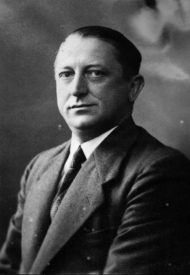
-
Dr. Richard Trommer (1910–1945)
Richard Trommer was born in Münnerstadt in the Mainfranken region. He studied medicine at the universities of Würzburg, Kiel, and Frankfurt am Main.
-
![]()
Picture: Federal Archives Berlin In 1933, he joined the Nazi Party, the National Socialist Student Union, and the SS. After obtaining his degree in 1936, he worked as an intern, resident, and assistant physician in several hospitals and mental hospitals.
Around the fall of 1941, Trommer was appointed camp physician for the prisoners’ section of the Flossenbürg concentration camp. At Flossenbürg, he killed inmates via poison injection. Later he worked as a physician in the Neuengamme and Ravensbrück camps. In Ravensbrück he participated in the selections of women who were murdered in the gas chambers. Trommer committed suicide shortly before the end of the war.
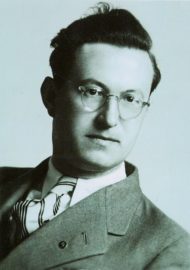
Guard Division
-
Ludwig Buddensieg (1884–1968)
Ludwig Buddensieg was born in Weißenfels an der Saale. After secondary school, he worked at a shipyard in Kiel. Later he joined the navy and took part in the First World War.
-
![]()
Picture: Federal Archives Berlin In 1919, he went into business in technical sales. However, his business languished due to the economic crisis. In 1927, he joined the Nazi Party, and in 1930 he joined the SS. After 1933, Buddensieg worked as an administrative director for the AOK health insurance company.
In August 1939, Buddensieg was transferred to the Flossenbürg concentration camp, where he headed a guard company. In 1943, he married for the second time, and had five children. He was discharged from the SS under unknown circumstances in March 1944.
In 1947, Buddensieg was sentenced to life imprisonment for his involvement in the shootings of prisoners. He was released in 1951.
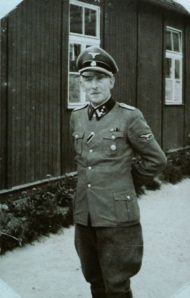
Site Management
-
Ludwig Petz (1912–unknown)
Born in Munich, Ludwig Petz trained as a bricklayer. In 1934, he completed an architecture and site engineering degree.
-
![]()
Picture: Federal Archives Berlin He worked as a Wehrmacht site engineer until 1938, and then was hired as an SS architect. He joined the SS in early 1940, receiving an immediate officer appointment.
In November 1941, Petz was appointed site engineer at the Flossenbürg concentration camp. He worked in the construction of the SS casino and the new Kommandant headquarters. Nothing is known about his interaction with prisoners. He was transferred to Serbia in July 1942. In late 1944, he was transferred to the 10th SS Railway Construction Brigade, which employed roughly 500 Jewish prisoners to repair bomb damage to the Offenburg and Ansbach railway networks. Unexploded ordnance and Allied air attacks led to many prisoner deaths.
Nothing is known about Petz’s later life and career.
